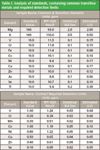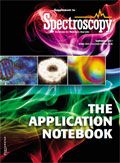EDXRF Analysis of Trace Elements in Aqueous Solution with UltraCarry
Elemental analysis of aqueous solutions into the low ppm and sub-ppm concentration ranges is demonstrated, using the advanced Cartesian geometry Rigaku NEX CG Energy Dispersive X-ray Fluorescence (EDXRF) spectrometer in conjunction with the patented UltraCarry? sample preparation technique.
Elemental analysis of aqueous solutions into the low ppm and sub-ppm concentration ranges is demonstrated, using the advanced Cartesian geometry Rigaku NEX CG Energy Dispersive X-ray Fluorescence (EDXRF) spectrometer in conjunction with the patented UltraCarry® sample preparation technique.
Trace element analysis of aqueous-based solutions is important in many areas, such as industrial manufacturing, quality control (QC) and quality assurance (QA) processes, environmental monitoring and remediation, as well as agriculture and general research.
To meet the challenges of trace analysis into the ppb range, Rigaku offers the NEX CG EDXRF analyzer and the UltraCarry sample preparation disk. With the Rigaku system, trace analysis can be carried out by non-technical operators and experts alike, without the need for special scientific training and costly, complicated, time consuming sample preparation.
Experimental Conditions
Analysis was performed with the NEX CG EDXRF analyzer and the UltraCarry sample preparation disk. UltraCarry is a novel disposable (single-use) sample carrier used to preconcentrate aqueous samples into a uniform thin film that is optimized for the suppression of background noise.
200 μL of each sample was pipetted onto the center of the UltraCarry pad. Samples were then dried using Rigaku UltraDry vacuum hotplate (75 Torr @ 68 °C for 15 min), followed by direct analysis with the NEX CG analyzer.
Results
A standardless calibration method was built using the Rigaku RPF-SQX fundamental parameters (FP) template for UltraCarry. RPF-SQX is an advanced FP program that automatically deconvolutes spectral peaks and models the thin film sample matrix using first principles. Providing a semi-quantitative measurement of concentrations without the need for known assayed calibration standards, the approach may be used for general screening and monitoring of aqueous solutions, industrial effluents as well as rinse and waste waters. Further refinement of the FP method may be effected by employing a Matching Library using from one to a few assayed samples to model a specific matrix. To demonstrate the standardless FP method, two certified ICP standards, containing common transition metals, were analyzed for 1200 s.

Table I: Analysis of standards, containing common transition metals and required detection limits
Conclusions
The Rigaku NEX CG combines secondary and polarization target excitation, with a high performance SDD detector, to deliver optimal EDXRF sensitivity. In conjunction with UltraCarry, the NEX CG is an ideal tool for the trace elemental analysis of aqueous solutions down to parts-per-billion levels. This technique is suitable for many analyses, including industrial and environmental applications.
Applied Rigaku Technologies, Inc.
9825 Spectrum Drive, Bldg. 4, Suite 475, Austin, TX 78717
tel. (512) 225-1796
Website: www.RigakuEDXRF.com

Newsletter
Get essential updates on the latest spectroscopy technologies, regulatory standards, and best practices—subscribe today to Spectroscopy.
Specificity and the Net Analyte Signal in Full-Spectrum Analysis
July 21st 2025This tutorial addresses the critical issue of analyte specificity in multivariate spectroscopy using the concept of Net Analyte Signal (NAS). NAS allows chemometricians to isolate the portion of the signal that is unique to the analyte of interest, thereby enhancing model interpretability and robustness in the presence of interfering species. While this tutorial introduces the foundational concepts for beginners, it also includes selected advanced topics to bridge toward expert-level applications and future research. The tutorial covers the mathematical foundation of NAS, its application in regression models like partial least squares (PLS), and emerging methods to optimize specificity and variable selection. Applications in pharmaceuticals, clinical diagnostics, and industrial process control are also discussed.
New Study Expands Nickel Autoionization Spectra to Advance Laser Isotope Separation Technologies
July 17th 2025Researchers at China’s National Key Laboratory have identified 170 nickel autoionization states using resonance ionization mass spectrometry, significantly advancing the spectral database critical for laser isotope separation and atomic spectroscopy.
AI-Powered Fusion Model Improves Detection of Microplastics in the Atmosphere
July 17th 2025Researchers from Nanjing University of Information Science & Technology have introduced a breakthrough AI-enhanced multimodal strategy for real-time detection of polyamide microplastics contaminated with heavy metals.
How Analytical Chemists Are Navigating DOGE-Driven Funding Cuts
July 14th 2025DOGE-related federal funding cuts have sharply reduced salaries, lab budgets, and graduate support in academia. Researchers view the politically driven shifts in priorities as part of recurring systemic issues in U.S. science funding during administrative transitions. The impact on Federal laboratories has varied, with some seeing immediate effects and others experiencing more gradual effects. In general, there is rising uncertainty over future appropriations. Sustainable recovery may require structural reforms, leaner administration, and stronger industry-academia collaboration. New commentary underscores similar challenges, noting scaled-back graduate admissions, spending freezes, and a pervasive sense of overwhelming stress among faculty, students, and staff. This article addresses these issues for the analytical chemistry community.